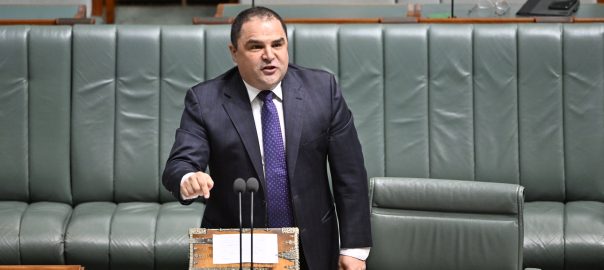PRIVATE MEMBERS’ BUSINESS Wine Industry

TONY PASIN MP
MEMBER FOR BARKER
SHADOW ASSISTANT MINISTER FOR INFRASTRUCTURE AND TRANSPORT
HANSARD
PRIVATE MEMBERS’ BUSINESS
Wine Industry
Mr PASIN (Barker) (18:35): I move:
That this House:
- notes the current crisis facing Australia’s wine grape growers;
- recognises that inland wine regions of the Riverland in South Australia, the Murray Darling and Swan Hill regions in New South Wales and Victoria, and the Riverina in New South Wales are being disproportionately impacted by the structural disequilibrium in supply of, and demand for, wine grapes;
- further notes that since 2021, average revenue per hectare of vineyard in these inland regions has dropped by 52 per cent;
- further recognises that many growers have been unable to cover their cost of production;
- acknowledges that without government intervention to support growers to adapt in this critical period, the wine grape growing sector will experience forced exits and widespread vineyard abandonment which can lead to significant biosecurity risks, attrition of younger generations in the affected areas, and adverse mental health consequences across regional communities; and
- calls on the Government to urgently support Australian wine grape growers with a targeted financial support package for eligible vineyard owners to adapt to changing market conditions.
The Riverland is Australia’s largest wine region area by area and by tonnage. The Riverland GI is 4,105 square kilometres. It includes 22,032 hectares of vineyards. The main varieties grown in the region are shiraz, chardonnay, and cabernet sauvignon. The wine industry is one of the major economic drivers in the Riverland. It’s worth around $400 million to the broader economy.
The region produces wines that are consumed in over 70 countries, from both commercial and boutique operators. The Riverland has traditionally exported as much as 3.6 million litres of wine, worth around $10.4 million. In the last decade, however, market factors have seen reduced demand for commercial wines from Australia, significantly impacting on the region. The lack of demand has seen prices for Riverland shiraz, cabernet and merlot fall from around $700 a tonne to just above $200 a tonne in 2023. I’ve also heard anecdotal evidence of prices as low as $120 a tonne. Prices are expected to fall further in 2024. There is a global oversupply of wine of about three billion litres a year—that’s three times Australia’s production. This is due to a number of factors: heightened awareness of the importance of health and wellness, competition from other alcoholic beverages, fewer wine drinkers drinking less wine, inflation, cost-of-living pressures et cetera. Australia has the equivalent of 859 Olympic swimming pools worth of wine in storage—that’s close to three billion litres.
I wrote to the state and federal ministers in 2022 about the looming crisis bearing down on Riverland wine grape growers, then again in 2023, and again earlier this year. Each time I was met with a standard response talking about efforts to improve trade with China. This freight train has been bearing down on the industry and, despite calls for action over the past 18 months, state and federal governments have been too distracted, or too complacent, to notice. Growers are now at crisis point. Growers in the Riverland are rightfully angry. They’ve been ignored by those opposite, and now they’re being told that trade with China will be the silver bullet that will fix all of their problems. This is blatantly dishonest and, quite frankly, insulting to multigenerational growers, who work their guts out to keep their businesses afloat. Those opposite need to level with growers. No single market will fix this problem.
Global wine production has exceeded supply since 2014. If we look to international examples, there have been plenty of attempts by various wine sectors to trade out of this global oversupply; they have all failed. As far back as 2006, France was dealing with excess production of some 750 million bottles of wine. Growers in Bordeaux have stopped tending to vineyards that are no longer economically viable. Bordeaux’s wine industry estimates that 2,000 to 3,000 hectares of vines have been simply abandoned. Abandoned parcels can be reservoirs for the spread of disease. Today, Bordeaux faces the removal of a further nine per cent of the region’s vineyards—some 9,500 hectares. Winemakers in Bordeaux are eligible for 6,000 euros per hectare in aid from the French government, either to help pay for the uprooting of their entire vineyard or to convert parts of their wine property to other agricultural pursuits. Well-established, mature markets such as Bordeaux can’t even trade out of this crisis.
In the US, industry leaders have called for growers to remove 50,000 acres, around nine per cent of California’s wine-grape-bearing acreage, to achieve market balance. The president of the peak industry group in California, Allied Grape Growers, says they are ‘structurally oversupplied’ and ‘have to adjust their acreage down’. Without government intervention to support growers in this critical period, our sector will experience forced exits; widespread vineyard abandonment, which could lead to significant biosecurity risks; the attrition of younger generations in the affected areas; and adverse mental health consequences, quite obviously.
Government must stop wasting time and must urgently support Australian wine grape growers with a targeted financial support package to help eligible vineyard owners adapt to changing market conditions. We want productive, sustainable agricultural sectors that drive economic growth and feed the nation. I urge those opposite to support growers in the Riverland to keep growing. Don’t let them flounder until they’ve got no choice but to sell their water as desperate sellers.
Keep farmers farming.
Media Contact: Charlotte Edmunds | Ph: 8724 7730








